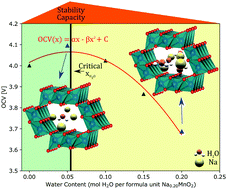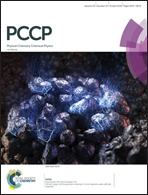Prediction of optimal structural water concentration for maximized performance in tunnel manganese oxide electrodes†
Abstract
Crystal water has been shown to stabilize next-generation energy storage electrodes with structural tunnels to accommodate cation intercalation, but the stabilization mechanism is poorly understood. In this study, we present a simple physical model to explain the energetics of interactions between the electrode crystal lattice, structural water, and electrochemically cycled ions. Our model is applied to understand the effects of crystal water on sodium ion intercalation in a tunnel manganese oxide structure, and we predict that precisely controlling the crystal water concentration can optimize the ion intercalation voltage and capacity and promote stable cycling. The analysis yields a critical structural water concentration by accounting for the interplay between elastic and electrostatic contributions to the free energy. Our predictions are validated with first-principles calculations and electrochemical measurements. The theoretical framework used here can be extended to predict critical concentrations of stabilizing molecules to optimize performance in next-generation battery materials.



 Please wait while we load your content...
Please wait while we load your content...
